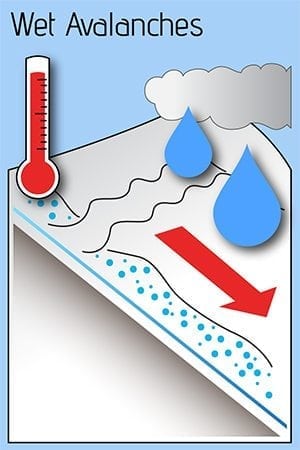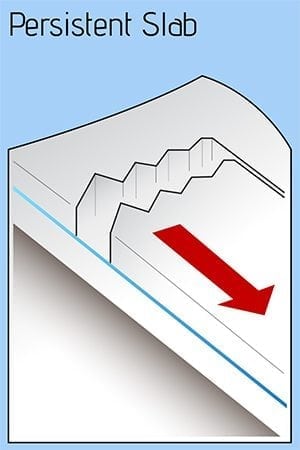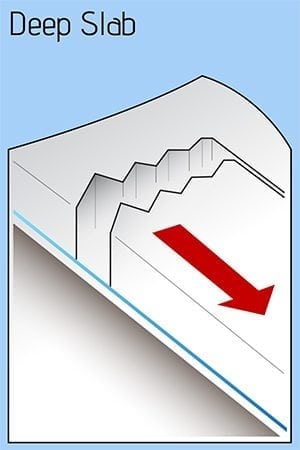Valdez
Above 4,000ftConsiderable
2,000 to 4,000ftConsiderable
Below 2,000ftConsiderable
The Avy Rose shows the forecasted danger by elevation and aspect. It adds more detail about where you are likely to find the dangers mentioned in the forecast. The inner circle shows upper elevations (mountain top), the second circle is middle elevations, and the outer circle represents lower elevations. Think of the Rose as a birds-eye view of a mountain, looking down from above. The rose allows our forecasters to visually show you which parts of the mountain they are most concerned about.
Degrees of Avalanche Danger
Avalanche Problems
Problem 1
Valley temperatures have remained above freezing for the last 48 hours with rain on snow occurring up to 1500′. As rain is able to saturate the upper snowpack and above freezing temps push deeper into the snow the likelihood and size of wet loose avalanche activity will be on the rise. Human triggered wet loose avalanches are likely in terrain steeper than 35° where the surface snow is wet and ski penetration is greater than 6 inches due to unfrozen snow. The size of wet loose activity will directly correlate with the vertical relief of the slope involved and the depth of unfrozen snow.
Avoid being exposed to or traveling on slopes steeper than 35° where the surface of the snow is wet or ski penetration is greater than 6 inches due to unfrozen snow. The hazard for this problem is on the increase as heavy rain on snow is occurring with high temperatures on the increase region wide. Wet loose activity may be able to step down to deeper layers in the snowpack creating more destructive avalanches.
Likelihood:
- Almost Certain
- Very Likely
- Likely
- Possible
- Unlikely
Size:
- Historic
- Very Large
- Large
- Small
Trend
- Increasing
- Steady
- Decreasing
Problem 2
Moderate to heavy precipitation is expected today with snow lines hovering around 1500′. This will translate to new snow up high putting pressure on the 4/22 buried surface hoar layer in specific locations, and rain down low increasing the likelihood for wet loose activity.
Triggering a persistent slab avalanche up to 2 feet in depth is likely today in specific locations at mid- upper elevations. 4-6 inches of heavy new snow has been recorded at Nicks over the last 24 hours, with an additional 6-12 possible today. This new snow will be adding stress to a layer of buried surface hoar that exists at high elevations on protected north aspects. The sensitivity of this layer will likely vary greatly from one location to another. Sensitivity will be affected by depth of new snow and the presence, or lack of buried surface hoar. Slope by slope assesment is encouraged if traveling in steep and/or consequential terrain of mid-upper elevations. It is recommended to avoid slopes steeper than 32° where buried surface hoar is identified with a cohesive slab above.

Surface hoar found on 4/21 prior to being buried on a north aspect at 5500′ just north of Hippie Ridge. This is a potentially dangerous weak layer at upper elevations as incremental snowfall increases stress on a layer that is notoriously weak in shear and can persist for long periods.
Likelihood:
- Almost Certain
- Very Likely
- Likely
- Possible
- Unlikely
Size:
- Historic
- Very Large
- Large
- Small
Trend
- Increasing
- Steady
- Decreasing
Problem 3
The likelihood of deep slab avalanche activity occurring, is slowly increasing as the overnight freezing line climbs in elevation. As our snowpack makes the transition from a winter pack to a spring one, deep slab avalanches become increasingly possible. The most likely trigger to this avalanche problem would include significant wet loose activity or cornice fall. It is highly recommended to avoid traveling on or exposing yourself to cornices, and steep solar aspects where the surface is saturated. As the season progresses and temperatures continue to rise, so does the possibility for deep slab avalanches to occur.
Weak snow exists at the base of our snowpack. On 4/15 our area saw the first deep slab activity occur since late February. This occurred on Meteorite (see avalanche activity section) and was a cornice fall that triggered a series of step down avalanches that eventually stepped down to the ground. This is a clear indication that large triggers can have an affect on depth hoar. Increasing temperatures are expected to produce more significant activity later in the season while our snowpack is undergoing a transition from a winter snowpack to a spring one.
This problem is very difficult to assess due its depth and the fact that signs of instability will likely not be present. You can stack the odds in your favor by avoiding steep terrain that is undergoing rapid changes such as strong solar and avoiding exposure to large triggers such as cornices.

Large natural avalanche on Meteorite triggered by cornice fall on 4/15.
Likelihood:
- Almost Certain
- Very Likely
- Likely
- Possible
- Unlikely
Size:
- Historic
- Very Large
- Large
- Small
Trend
- Increasing
- Steady
- Decreasing
Avalanche Activity
Below is a summary of observed Avalanche activity from the last 7 days. Avalanches that were noted earlier in the season can be viewed by clicking the link below.
If you trigger or observe an avalanche consider leaving a public observation.
4/17- Large natural avalanche reported on the upper Tasnuna just east of “The Wall”. Cornice fall was likely the initial trigger with other sympathetic avalanches occurring as well as full depth step downs. SS-Nc-R2.5-D3

– Skier triggered avalanche reported in the Tasnuna valley “The Hammer” SS-ASu-D2-I down 40 cms on 4/7 buried surface hoar/ NE aspect ~5500′. 5th Skier on slope was caught and partially buried in a crevasse/ skier did not sustain any major injuries.
4/15- A cornice fall produced a series of step down avalanches on Meteorite which resulted in failure at the ground. This intiatied as a cornice fall at 6500′ that triggered an avalanche most likely at the 3/9 interface which then stepped down to a persistent slab around 6100′ NE and stepped down to the ground at 5600′ NE.
SS/HS-NC-D3-O/G 6200′ NE, step down to ground ~5600′ NE

Weather
Check out our updated weather tab! A collection of local weather stations are available for viewing with graphs and tabular data included.
NWS Watches, warnings and advisories
NONE
NWS Point forecast for Thompson Pass
Date Friday 04/28/23 Saturday 04/29/23 Time (LT) 04 10 16 22 04 10 16 22 04 Cloud Cover OV OV OV OV OV OV OV OV OV Cloud Cover (%) 90 100 100 100 90 100 100 95 85 Temperature 30 31 32 30 28 32 37 34 30 Max/Min Temp 33 27 37 29 Wind Dir S S SE NE NE NE E S SW Wind (mph) 11 8 5 4 18 16 10 4 5 Wind Gust (mph) 32 Precip Prob (%) 90 80 80 70 50 80 80 60 40 Precip Type S S S S S S S S S 12 Hour QPF 0.30 0.16 0.27 0.17 12 Hour Snow 2.7 1.2 1.9 0.6 Snow Level (kft) 1.4 1.2 1.4 1.2 1.3 1.5 2.2 2.1 1.5
Click on link below for Thompson Pass weather history graph:

| Date:
04/28 |
24 hr snow | HN24W* | High temp | Low temp | 72 hour SWE* | April snowfall | Seasonal snowfall | Snowpack Depth |
| Valdez | 0 | .31 | 47 | 34 | .40 | 11 | 248 | 29 |
| Thompson Pass | N/O | N/O | N/O | N/O | N/O | 12 | 438 | N/O |
| 46 mile | 0 | 0 | 48 | 32 | .2 | ~5 | ~117** | 38 |
*HN24W- 24 hour Snow water equivalent in inches
*SWE– Snow water equivalent
**46 mile seasonal snowfall total begins December 1st.
Additional Information
Click on the link below for a running summary of the seasons weather history.
Announcements
The avalanche hazard is Considerable at all elevations. Human triggered avalanches are likely up to 2 feet in depth. Natural avalanches are possible. Heavy rain below 1500′ and 6-12 inches of new snow at upper elevations will be increasing the likelihood of multiple avalanche problems. The likelihood and size of wet loose avalanches that could occur today is on the increase. At upper elevations new snow is adding stress to a weak layer in the upper snowpack increasing the likelihood of human triggered storm/ persistent avalanches. Avoid avalanche terrain that has become isothermal at low elevations and observe the depth and sensitivity of new snow at mid-upper elevations.
Posted by Gareth Brown 04/28 8:00 am. The last avalanche forecast will be posted on April 30.
For a description of current avalanche problems, weather information, season history and more click the (+ full forecast) button. Avalanche forecasts will be issued Wednesday-Sunday through April 30th.
If you have pictures of recent natural or human triggered avalanches or notice signs of instability such as shooting cracks or collapsing, leave an observation to help improve forecast accuracy.


